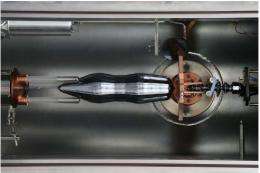October 20, 2010 report
Accurate Avogadro constant may help redefine the kilogram

(PhysOrg.com) -- A new accurate determination of the Avogadro constant has used the method of "counting" the atoms in a 1 kg sample of an almost perfect silicon sphere highly enriched with the isotope 28Si. They used isotope dilution mass spectroscopy to determine the molar mass of the silicon with unprecedented accuracy, and this enabled them to obtain the most accurate value for the Avogadro constant ever obtained.
The Avogadro constant NA (or L) is the number of atoms (or molecules) in a mole of a substance. It therefore relates the molar mass to the mass and gives a fixed point from which mass can be defined. An accurate determination of this constant is important if the kilogram is to be defined in terms of a fundamental constant. At the moment the constant’s value is set by a committee that averages values found by experiments deriving the constant by different methods.
A redefining of the kilogram is considered necessary because since 1889 the international standard is based on the weight of a cylinder of 90% platinum and 10% iridium stored under glass in a vault at the International Bureau of Weights and Measures in Paris, France. The problem is the cylinder (and its six copies) gains weight from dust despite all the precautions against this, and then loses it again when subjected to a steam bath to remove the dust. It also seems to be gaining about 50 micrograms in weight per century, so scientists would prefer a definition that is defined by reference to a constant.
Teams of researchers from Europe, Japan, Australia, Russia and the US, were involved in the project. They chose silicon for the experiments because almost perfect single crystals can be grown and atoms within the crystals line up with eight atoms to each cube. Samples of silicon usually contain mixes of isotopes 28Si, 29Si, and 30Si along with impurities, so the team asked Russia’s Central Design Bureau for Machine Building in St Petersburg, which usually enriches uranium, to enrich silicon and produce a sample of 99.99 percent silicon-28. The researchers then used the enriched silicon to grow a 5 kg crystal that they used to make two almost perfect spheres.
Engineers spent the next two years grinding and polishing the spheres to as close to perfection as possible. Physicist Arnold Nicolaus, of the Physikalisch-Technische Bundesanstalt in Germany, said if the spheres were enlarged to the size of the Earth, the highest hill would stand less than three meters tall.
The atoms in the spheres were counted by measuring the volume using laser interferometry and then using X-ray diffraction to measure the distance between the (evenly spaced) atoms in the crystal structure. Niclaus compared the process to counting cans in a mound of 12-pack cartons. If the volume of the mound and the dimensions and spacing of the cartons are known the number of cans can be calculated.
The final result for Avogadro’s constant was 6.02214084(18) x 1023 mol-1, with an uncertainty of 30 parts per billion. This is the most accurate ever obtained but the uncertainty needs to be reduced to below 20 parts per billion before the International Committee for Weights and Measures will consider redefining the kilogram. This is because the uncertainty of the cylinder’s mass is 20 parts per billion. The research team hopes the uncertainty can be reduced by refining the measurements, but this may take two or more years.
More information: An accurate determination of the Avogadro constant by counting the atoms in a 28Si crystal, B. Andreas, et al., arXiv:1010.2317v1 [physics.atom-ph] arxiv.org/abs/1010.2317
© 2010 PhysOrg.com















